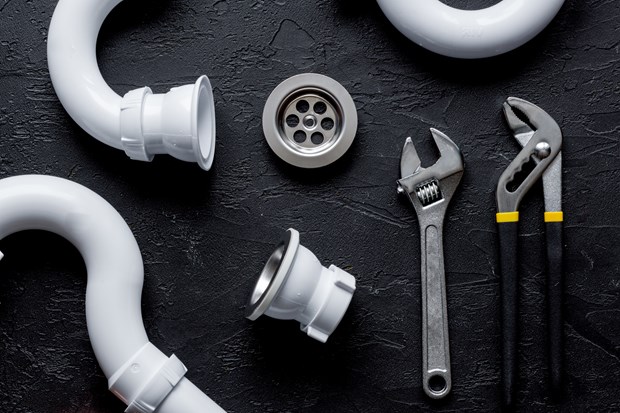If you reach for the phone every time you have a drip, a leak or a clog, you’re probably wasting a lot of money. A little bit of plumbing know-how can go a long way in saving you money on basic fix-it jobs. Obviously, there are some plumbing emergencies that aren’t for a novice. But it’s always a good idea to try to fix something yourself before you call in the big (expensive) guns. Saving money on something that you can do yourself can feel like winning the Grande Vegas online casino jackpot!
Declog a Toilet
If your toilet clogs, try a plunger. If you don’t have a plunger, or if plunging doesn’t work, the clog might break down with hot water if the clog is organic or toilet paper.

To unclog with hot water, first turn off the water that flows into the toilet. Either open the cover on the tank and disconnect the chain to keep the valve closed or turn off the water at the valve which should be located at the side of the toilet.
Then, pour a cup of hot water (the hotter the water, the better) into the toilet. If the hot water doesn’t work on its own, try adding some soap.
If all else fails, put on a pair of gloves and reach your hand down into the toilet and pull up the material that’s blocking it.
Dripping Faucet
It’s the rare homeowner who hasn’t had a leaky faucet. Aside from the wasted water, the steady dripping sound can be enough to make anyone go banannas.
The most common reason for a drippy faucet is a loose screw inside the tap. If you unscrew the little cover on the top of each tap, you’ll be able to check the screw that’s inside. Once you tighten it with a screwdriver you can replace the top. In the majority of cases, this simple fix is all it takes.
Leaky Pipe
Pipes are made with a variety of materials – plastic, copper, galvanized steel and iron, polyvinylchloride (PVC), cross-linked high density polyethylene (PEX), chlorinated polyvinylchloride (CPVC) and polybutylene. There’s a silicone self-sealing tape that you can use to wrap around a leaky pipe and seal it.
It’s not an indefinite solution but it can last for years and buy you some time to budget for a pipe replacement. When you’re ready to start sealing up the pipe, wipe the pipe dry. Then wrap the tape around the leak. The tape will stretch as you wind it repeatedly around the pipe. This will create a water tight seal.
Smelly Drain
If there’s a smell coming from the sink or the shower drain, it’s probably coming from the drain trap. The trap is the squiggle bend that’s under your sink/below the shower drain and its job is to trap odors. As water flows through the pipes, some water is trapped in the U part of the bend and stays there.
The idea is that the water will create a seal that will prevent smells from traveling back up the pipe and out through the drain. A smell can develop if you haven’t used the sink in awhile (which would move the old water down the drain and bring in fresh new water).
Run some water down the drain for several minutes. That water will fill the trap and release the odor. You can also check underneath for leaks – odors might develop if the u bend is leaking. If so, check above for DIY regarding sealing leaking pipes.
Unclog a Sink Drain
Sometimes you need to take apart the pipes under the sink in order to unclog a sink drain but it’s not always necessary. It’s also not necessary to go out and buy expensive, caustic chemicals to break down the materials that are clogging your sink.
Before you do anything complicated, take out your baking soda and vinegar. Pour 1 cup of baking soda into the clogged drain and then immediately pour in one cup of vinegar. Cover the drain immediately so that the chemical reaction between the vinegar and the baking soda can start to activate. That reaction helps loosen food and debris that are trapped in the drain so that it can be washed away.
Wait 5 minutes and then pour a pot of boiling water down the drain to wash everything away. Repeat the process if it doesn’t work the first time.
Leaky Shower Head
If there’s water spraying out of your showerhead at the spot that the showerhead connects to the hose, you can seal it with sealing tape. Turn the water off and dry off the area where it’s spraying out. Unscrew the showerhead from the hose if the water is spraying out from the hand held on a hose or unscrew the hose from the wall mount if that’s where the water is spraying.
If water is spraying from the wrong parts of your showerhead, there’s a simple fix. First, pick up some thread sealing tape. Make sure the water is turned off tightly and remove the showerhead by unscrewing it. If it’s a hand held on a hose, you’ll need to unscrew the head from the hose, and the hose from the wall mount. Pick any old threat tape off and wrap new thread tape around the threaded end of the connector. Then screw everything back the way it was.
Thread tape is light silky tape which can seal the threads so water can’t escape between the spaces of the threads.
Low Water Pressure in the Shower
If the water pressure drops in the shower, and only in the shower, it’s likely…..the shower head. Sometimes calcium deposits build up inside the shower head which impedes the flow of water.
You can clean your showerhead quickly and easily (and cheaply). Unscrew the showerhead from the hose and soak it in white vinegar for a few hours. Then reattach it to the hose.
Save Money and Water
You can save money and water by flushing less water with every flush. The way that you do this is to limit the amount of water in the toilet tank. Fill up a 20-ounce water bottle and place it in the corner of your toilet tank.
The bottle will displace water from the tank so less water will enter the tank and less water will be used with every flush. Every time you flush, the displacement means less water will be used. The bottle should stay at the bottom – it if floats freely it will interfere with the flushing mechanism.







